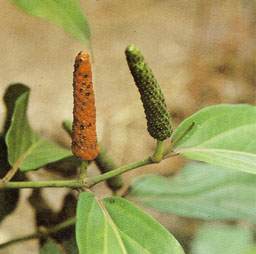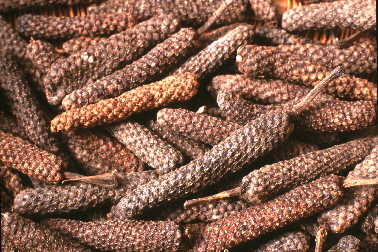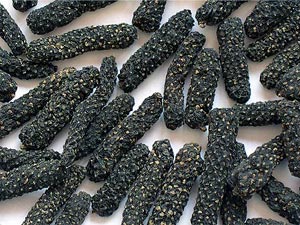|
Scientific name: Piper longum L.
Family: Piperaceae
Common names: Indian long pepper, bengal pepper, pipal
Thippali is a perennial medicinal plant found all over India, having extensive
use in indigenous herbal and ayurvedic preparations. It is a vital ingredient of
more than 320 classical ayurvedic and herbal preparations. Dried unripe berries
or spikes of long pepper are the medicinally important parts.

Origin
Thippali has its origin in Indo Malay region. The plant grows wild in tropical rainforest
of India, Nepal, Sri Lanka and Philippines. In India it is grown commercially in
Assam and West Bengal and also to a smaller extent in Kerala, Karnataka, Tamil Nadu
and Uttar Pradesh. However, bulk requirement of thippali is derived from wild growth
from Assam, Shillong, West Bengal and also from Indonesia.
About the plant
Thippali belongs to the family of black pepper, Piperaceae. The plant is a slender,
glabrous, climber or creeping shrub that spreads on ground striking roots at each
node. It produces two distinct dimorphic branches – vegetative main branches that
creep on ground; and erect growing reproductive axillary branches. The plant flowers
through out the year and is dioecious in nature with the male and female flowers
produced on different plants. Inflorescence is spike; about 35 millimetres long
and 5 millimetres thick, composed of large numbers of minute grayish green or darker
grey fruits, which, together with the bracts that support them, are embedded in
the elongated axis; and the the whole being covered with greyish dust.
Climate & Soil
Thippali grows well in organic matter rich fertile, well-drained soils. Laterite
soils with high organic matter content and moisture holding capacity are also suitable
for the cultivation. Optimum elevation for its cultivation is between 100 to 1000
m and higher elevations are not conducive to high yields. Partial shade of 20-25
per cent shade intensity is found to be the optimum.
Varieties
Different types of thippali - cheemathippali, cheru thippali, vanthippali, kattu
thippali are identified. Cheemathipali is a common cultivated
clone of Kerala. Viswam is a high yielding variety of thippali released
by the Kerala Agricultural University for commercial cultivation. It recorded 800
to 850kg dry spikes per hectare in open condition and 350 to 400kg in coconut gardens
during second year of planting.
Nursery preparation
Thippali is propagated by rooted vine cuttings or suckers. Vine cuttings of 3-5
nodes are planted in polybags filled with top soil, farm yard manure and sand in
the ratio 1:1:1 during March-April. Normal irrigation may be given on alternate
days. Excess moisture in the nursery can cause Phytophthora wilt. To avoid
mealy-bug attack on roots, 10 per cent DP of any organo-phosphorus insecticide is
to be mixed with the potting mixture. Cuttings will root in two weeks and can be
transplanted to the main field after two months.
Land preparation and sowing
The field should be ploughed two to three times and levelled properly. Raised beds
of 1m width and convenient length are prepared and pits are dug at a distance of
60 cm x 30 cm. Dried cow dung or farmyard manure at the rate of 2kg per pit is applied
and mixed with soil. Application of chemical fertilizers is not practiced commonly.
Plant two rooted cuttings or suckers per pit in the main field soon after the onset
of monsoon (May-June).
Weeding
In the first year, regular weeding should be done as and when the weed growth is
noticed in beds.
Manures and fertilisers
Thippali needs heavy manuring for luxurious growth. In soils with low fertility,
growth of the plant is very poor. Twenty tonnes of cow-dung or farm yard manure
is required for 1 ha of land. Since the crop will give economic yield for 3 years,
manuring has to be done each year. During the first year organic manure can be applied
in pits at the time of field planting. In subsequent years, manuring is done by
spreading it in beds and covering with soil. Application of organic manure increases
the water holding capacity of the beds.
Irrigation
Crop irrigated during summer, continues to produce spikes even in the off-season.
If grown as pure crop, it is better to irrigate once in a week during summer months
and if grown as an intercrop, irrigation to the main crop will be sufficient for
thippali also and there is no need to irrigate thippali separately. Care should
be taken to avoid water stagnation in beds; and channels are to be laid out to drain
excess rain water. Sprinkler irrigation is also beneficial. When the crop is not
irrigated, it is necessary to give mulch with dry leaves or straw during summer
months.
Pest and diseases
Spray 1% Bordeaux mixture against leaf and vine rot; and necrotic spots and blights
on leaves. Any systemic insecticide will control mealy bug attack. If the attack
of adults and nymphs of tea mosquito (Helopeltis theivora) is found serious,
spray neem seed kernel extract @ 0.25%. For controlling nematodes (Meloidogyne incognita
and Radopholus similis) associated with Thippali apply Pseudomonas fluorescens
(Pf1) @ 10g/plant is recommended.
Harvesting and yield
The vines start bearing spikes six months after planting. Spikes will be ready for
harvest after two months since formation of spikes. Fully grown but unripe fruits
are to be harvested. Harvesting at correct maturity is important as delay in harvest
leads to loss of pungency. The yield of dry spike during the first year is around
400 kg/ha., it increases up to 1000 kg/ha in the third year. After the third year,
vines become less productive and should be replanted. Thicker parts of lower stems/roots
are also cut and can be used for making Piplamool after drying properly.

|

|
|
Harvested spikes
|
Post-harvest operations
Harvested spikes are repeatedly exposed in the sun for 4-5 days until they are perfectly
dry. The green spike to dry spike ratio is around 10:1.5. Dried spikes have to be
stored in moisture proof containers. Long pepper of commerce is the dried, unripe
spike about 35 mm long and 5 mm thick, brown or blackish in colour. The product
has a hot and warm sensoric quality similar to those of black pepper, but not so
strong and with slight sweet overtones. The produce fetches price according to the
grade. Piplamool, product made of the dried thicker parts of lower stems/roots is
of three grades. The grade I with thick roots and underground stem fetching higher
price than grade II and III which comprise either roots, stem or broken fragments.
Main constituents
The chief constituents of thippali are about six per cent of piperine and one per
cent of volatile oil. Other constituents are a pungent resin namely chavicin and
starch. Compounds like piper longuminine, cetostearol, methyl piperate and a series
of piperine retrofractamides have also been reported.
Medicinal and therapeutic use
In India, thippali is used mainly in the preparation of pickles and health stimulants
like 'chawanprash' and also for imparting flavour and pungency to beverages.
But it has well identified medicinal properties. Piper longum is most commonly
used as an expectorant to treat respiratory ailments such as asthma, bronchitis,
cough, cold etc. and has aphrodisiac, analgesic and carminative properties. In Ayurvedic
medicine, the herb is said to be a good rejuvenator and helps improve vitality;
and is employed as a tonic to stimulate appetite. It is also being used against
stomachache, spleen diseases, tumors, indigestion, epilepsy, flatulence, gout, laryngitis
etc. This herb has nerve depressant and antagonistic effects on muscular spasms;
and when applied topically, it soothes and relieves muscular pains and inflammation.
The oil extracted has antibacterial and antihelminthic properties.
|